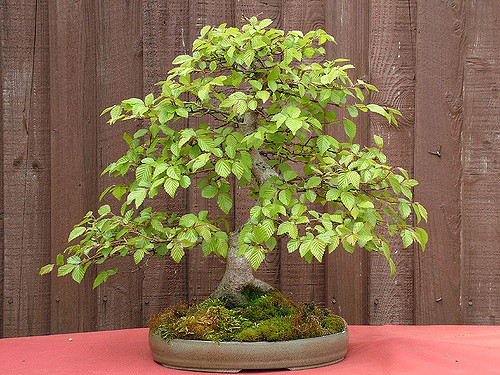The genus Carpinus, better known as hornbeam, consists of about 40 species scattered around the world in the northern hemispheres. The genus contributes more than its fair share of excellent bonsai candidates. The United States features C.carolinina which is native to the eastern part of the country and collected plants can be found in bonsai collections there. Europe has both C. orientalis, growing in Italy, and C. betulus growing from Europe to as far east as Iran. Asia outdoes itself with two species from Korea, C. coreana and one with the somewhat indigestible name of C. turkzaninowii. Both are sold in the bonsai world as Korean hornbeams. Japan’s offerings are C. japonica, C. laxiflora and C. tschonoskii and are sold collectively as Japanese hornbeams. To further gum up the taxonomic issue, Japanese hornbeams are sold sometimes as Korean hornbeams. The minor differences between these species are the life blood of the botanical world, but as bonsai material they all pretty much look and grow alike. What is of significance is that if your “Korean hornbeam” is a little different from a “Korean hornbeam” that you see in a bonsai show, it probably means that you are looking at two different species of Carpinus.
All of the species of Hornbeams grown as bonsai are splendid trees. They happily grow in bonsai pots for many years and can patiently endure a bit of neglect. As a group the trees all have small leaves that have a rather crinkled texture, as well as smooth and fluted gray bark. When the leaves have fallen in winter, the fine branch structure and the gray bark provides wonderful winter silhouettes. As an added benefit, the leaves turn a beautiful color in the fall which is usually a bright yellow, but in some trees, that color can be red or a yellow-bronze. The fall color presents a pleasing contrast to the gray trunk. Hornbeams are relatively slow growing trees and so you can take a more relaxed approach to them as bonsai in contrast to lushly growing trees such as redwoods, for example which require a lot of constant attention. A disadvantage of slow growth is that it takes a lot of time to develop a significantly thick trunk.
for many years and can patiently endure a bit of neglect. As a group the trees all have small leaves that have a rather crinkled texture, as well as smooth and fluted gray bark. When the leaves have fallen in winter, the fine branch structure and the gray bark provides wonderful winter silhouettes. As an added benefit, the leaves turn a beautiful color in the fall which is usually a bright yellow, but in some trees, that color can be red or a yellow-bronze. The fall color presents a pleasing contrast to the gray trunk. Hornbeams are relatively slow growing trees and so you can take a more relaxed approach to them as bonsai in contrast to lushly growing trees such as redwoods, for example which require a lot of constant attention. A disadvantage of slow growth is that it takes a lot of time to develop a significantly thick trunk.
A common name for the European species is Ironwood because the wood from hornbeams is very hard and heavy. The wood has been used (and still is) for bodies of woodworking tools such as planes. As a result, it is not surprising that bending of major branches of hornbeam bonsai trees is a job for the Pacific Coast Crane, Dredge and Pile Driving Company and their heavy equipment. Major branches can, in fact, be bent but the process is slow and difficult. On the other hand, young branches are quite pliable and can be easily bent. The moral of this story is that you need to carefully place young branches because once they are mature bending them is a hassle.
The trees grow by sending out long thin shoots which require several years to enlarge into significant branches. These new branches can be easily wired into place or, if desired, can be cut off just above the last two leaves above the branch they are emerging from. This approach to styling the tree makes the clip-and-grow technique a valuable tool in achieving your design for the tree. Hornbeams make splendid candidates for group plantings because of fine branch structure and the beautiful gray bark. Unfortunately, group plantings of hornbeams are very rarely seen at local bonsai shows.
Hornbeams are understory trees in nature which means that they grow below the forest canopy. As a result, they get along just fine in bright shade although they grow more vigorously in full sun. The leaves can be scorched by very hot sun or windy days. It appears that they would enjoy a little protection from the sun and wind in the hottest days of summer east of the hills in the bay area but they should be fine west of the hills.
Hornbeams are wonderful trees for bonsai on many levels. They are easy to grow and style and they are attractive all year long. They are great trees for beginners. Unfortunately, they are underappreciated by the bonsai community. If you see them offered for sale at a bonsai nursery or at a show, do strongly considering adding one to your collection. You will be handsomely rewarded.

